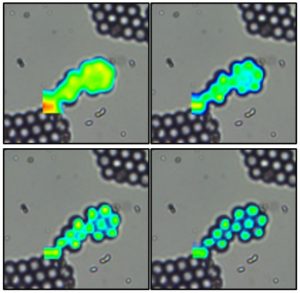Spatial Resolution in Raman Spectroscopy
In Raman microscopy, spatial resolution is vital for discriminating different structures in a sample. The better the spatial resolution the more detailed information can be gained. For example, differentiating different components in a single cell or detecting defects in graphene materials. Lateral and axial resolution are governed by different parameters, however to achieve the highest resolution for both a confocal Raman microscope needs to be used.
Lateral Resolution
Two factors contribute to the lateral (XY plane) resolution: the excitation wavelength and the microscope objective used. Theoretically, the spatial resolution can be calculated:

Figure 1: polystyrene beads mapped on the RM5 Raman Microscope with varying pinhole sizes A) 25 mm B) 100 µm C) 50 µm D) 25 µm
For applications where spatial resolution is critical, immersion objectives can be used to obtain a higher NA. Here an immersion fluid is placed between the front lens of the objective and a coverslip/sample where in normal objectives air would be. The immersion liquid increases the amount of light reaching the objective by reducing the amount of reflection and refraction of light from the sample. This is achieved by using immersion fluids with refractive indices higher than that of air, which is 1. The two most commonly used fluids are water with a refractive index of 1.3, and oil which has a refractive index of approximately 1.5 (dependant on oil type). Water immersion objective have particular use in confocal Raman microscopy for the study of live cells in cell media, whilst oil objectives can be useful for depth studies.
Axial Resolution
Axial resolution (Z axis) is more complicated, in terms of simply optical microscopy it is proportional to λ/NA2. However, for Raman microscopes both the detection and focusing optics need to be considered. Crucially resolution relies on the confocal design of the instrument and the pinhole diameter, depth resolution in the order of 1 µm can be achieved under ideal conditions. To find out more about the relationship between pinhole diameter and resolution read our post on the role of the pinhole in Raman microscopy. As well as the confocality of the system, the laser wavelength, microscope objective, and sample will affect the achievable depth resolution. Figure 2 shows a 3D Raman map revealing the layers of a transdermal patch. The resulting volume render clearly shows the separate layers of the patch coloured to represent PET (red), PET/PIB (pink), PE (blue) and the active ingredient (green).
3D rotated view of patch 785 depth map 300um pinhole crop.tif
Figure 3D confocal Raman map of a transdermal patch mapped on the RM5 Raman Microscope









